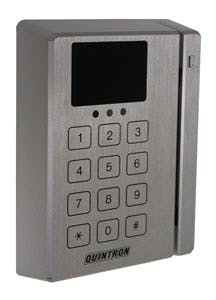A joint effort by Barantec and Quintron has brought a new card reader/key pad unit, the Tri-Guard, that combines and transitions three technologies, keypad, magstripe and proximity, to the market. The new Tri-Guard reader from Barantec and Quintron offers a number of benefits to end users especially in areas such as the government and educational markets where magstripe technology has been prevalent.
Since the cost to transition all magstripe cards and readers to proximity cards and readers can be high, having both technologies in the same unit is a workable solution. In addition, since magstripe cards are less expensive than proximity ones, the cost is often more appropriate for temporary users.
"The three technologies is a perfect transition for many applications," said Rick Foster, director of marketing and sales for Quintron. "In large government facilities where there are thousands of magstripe users, the current users can continue with the mag cards, but the new people can receive a prox card. They can then slowly transition out from using the magstripes instead of replacing them all at once.
"In addition, rather than using the more expensive prox card for temporary students on college campuses, they can now give them a temporary mag card that could be thrown away," added Ayal Vogel, president of Barantec.
The joint design between the two companies incorporates Barantec's "Everswitch Inside" patented piezo technology. The piezoelectric effect is the property exhibited by certain crystals of generating voltage when subjected to pressure and conversely, undergoing mechanical stress when subjected to an electric field. The sensors embedded below the metal surface of the keys are made of a ceramic alloy that only needs pressure to activate. There are no moving parts to wear out and all numbers are hard-anodized for years of use without wear.
"We were able to build readers using Barantec's unique production techniques in small quantities without spending large amounts on tooling," added Foster. "We pioneered the combination of three of the most common reader technologies in our Architectural-Class TripleTech reader: a piezo keypad for long life, a low or high frequency RFID reader, plus a single or dual head high reliability magnetic stripe reader."
Each of these technologies is available in any combination and interfaces with the Quintron panel or with any other Weigand or ABA compatible panel using a single six-wire cable. An optional Weigand to RS232 serial interface is available for direct connection to a PC for enrolling cards into a database. A combination of a selection of colors and finishes in the solid billet aluminum case is available. Keys have raised dots to comply with the American with Disabilities Act (ADA) standards.
In addition, Tri-Guard is easy to install, vandal proof and impervious to the elements. The unit is able to withstand user abuse, harsh environments and temperatures ranging from -31 degrees to 150 degrees F. With a standard Wiegand output, Tri-Guard is compatible with almost all access control systems.
As part of the Quintron's Architectural-Class reader family, single or dual technology versions of the readers are available as RFID only, Mag Stripe Only, Keypad only, or in any combination.
For more information on Quintron, visit www.quintron.com.


